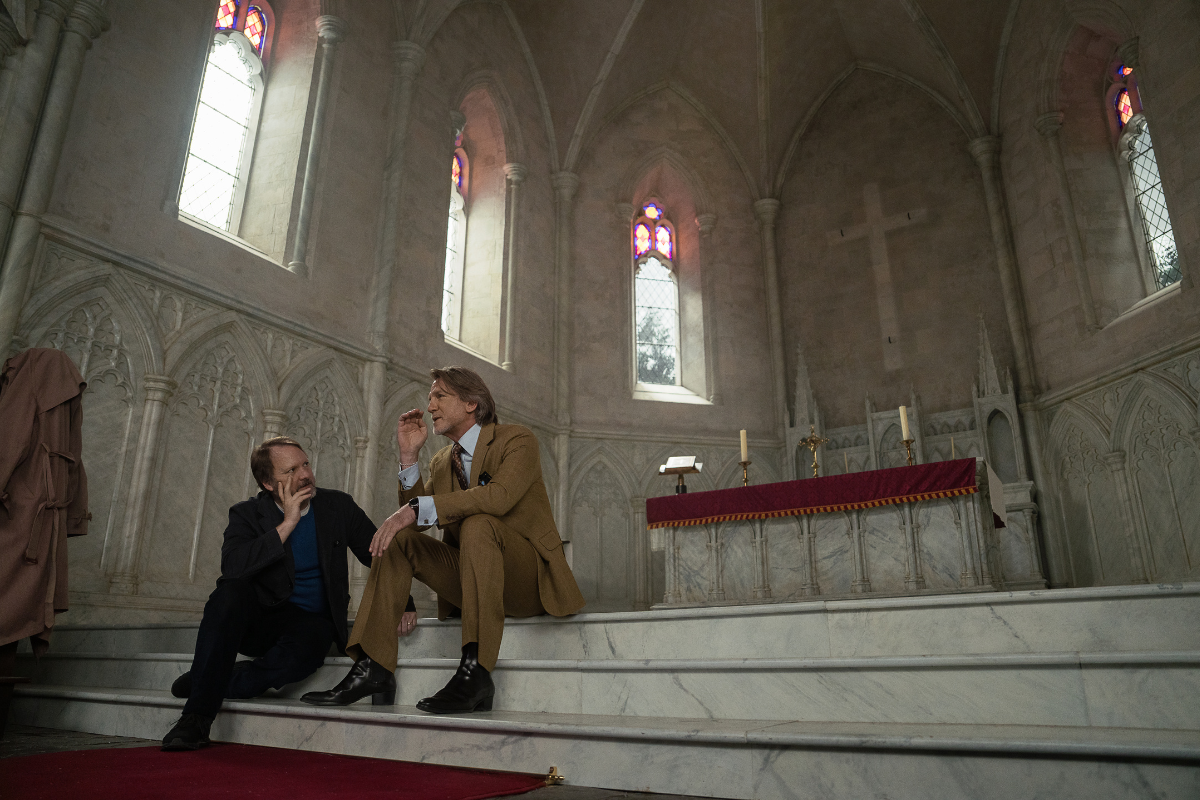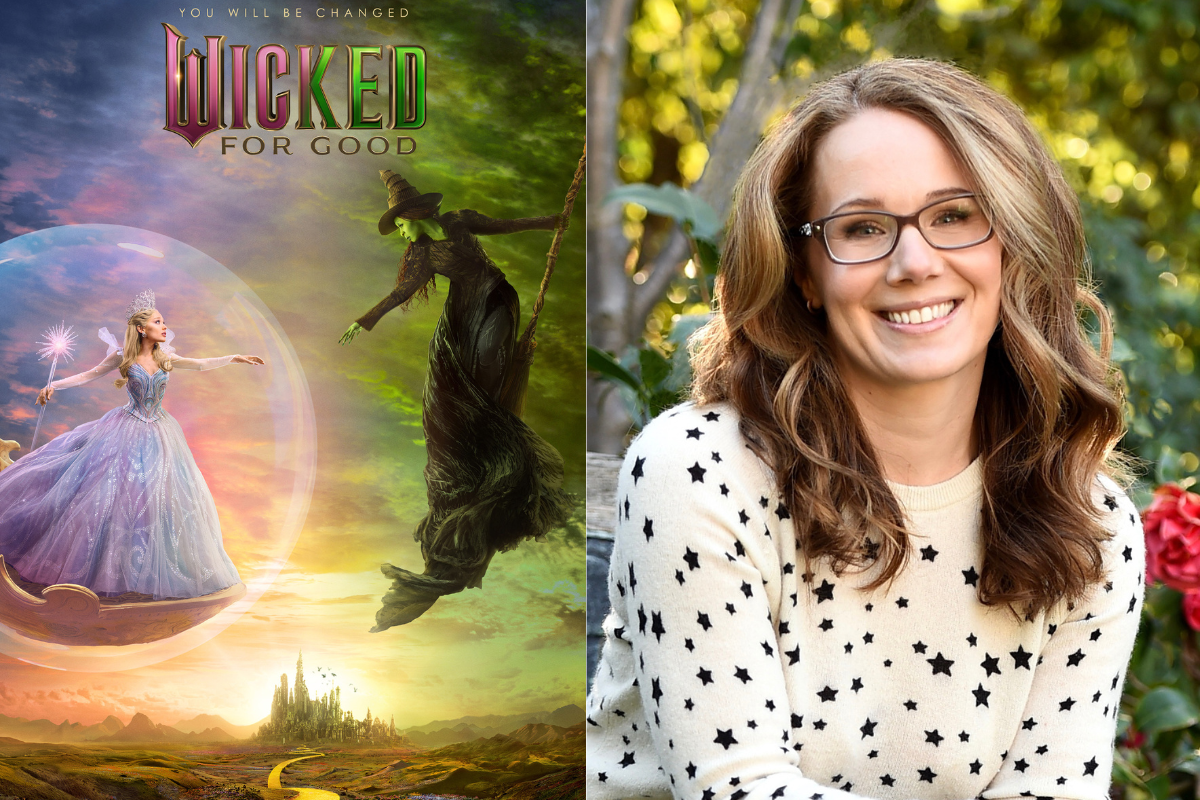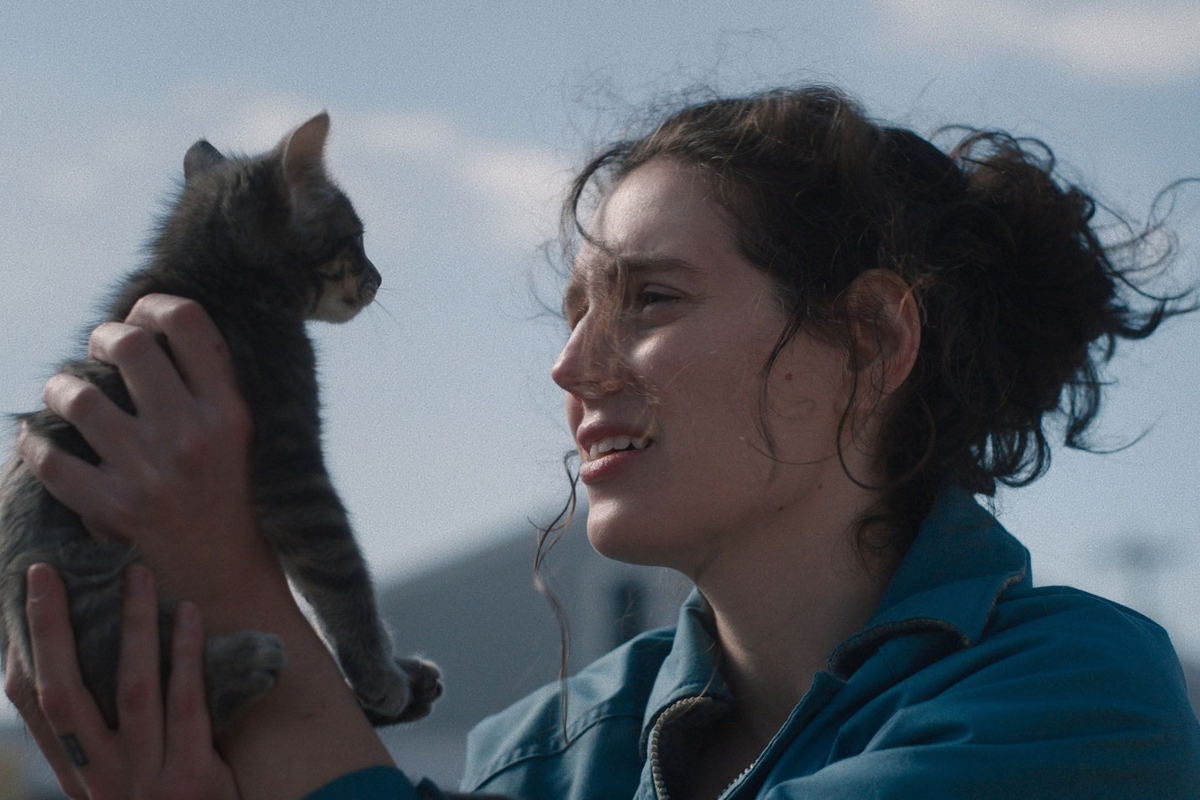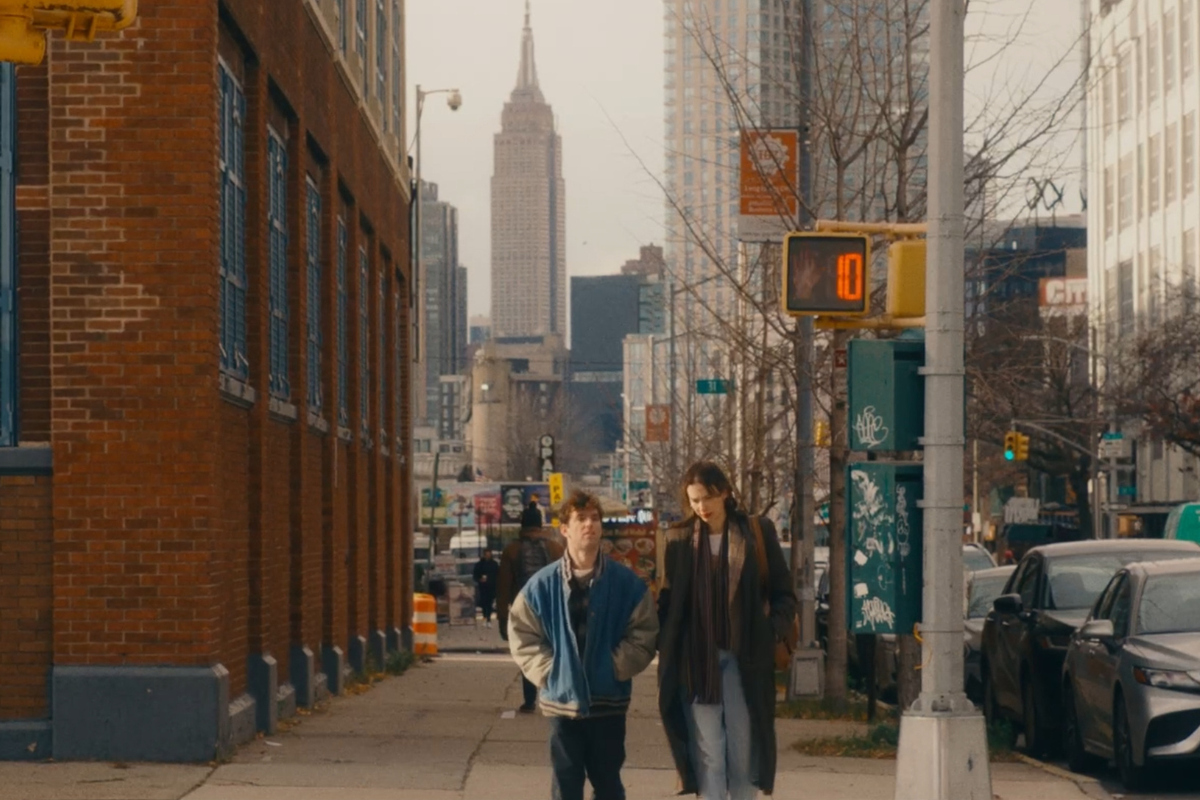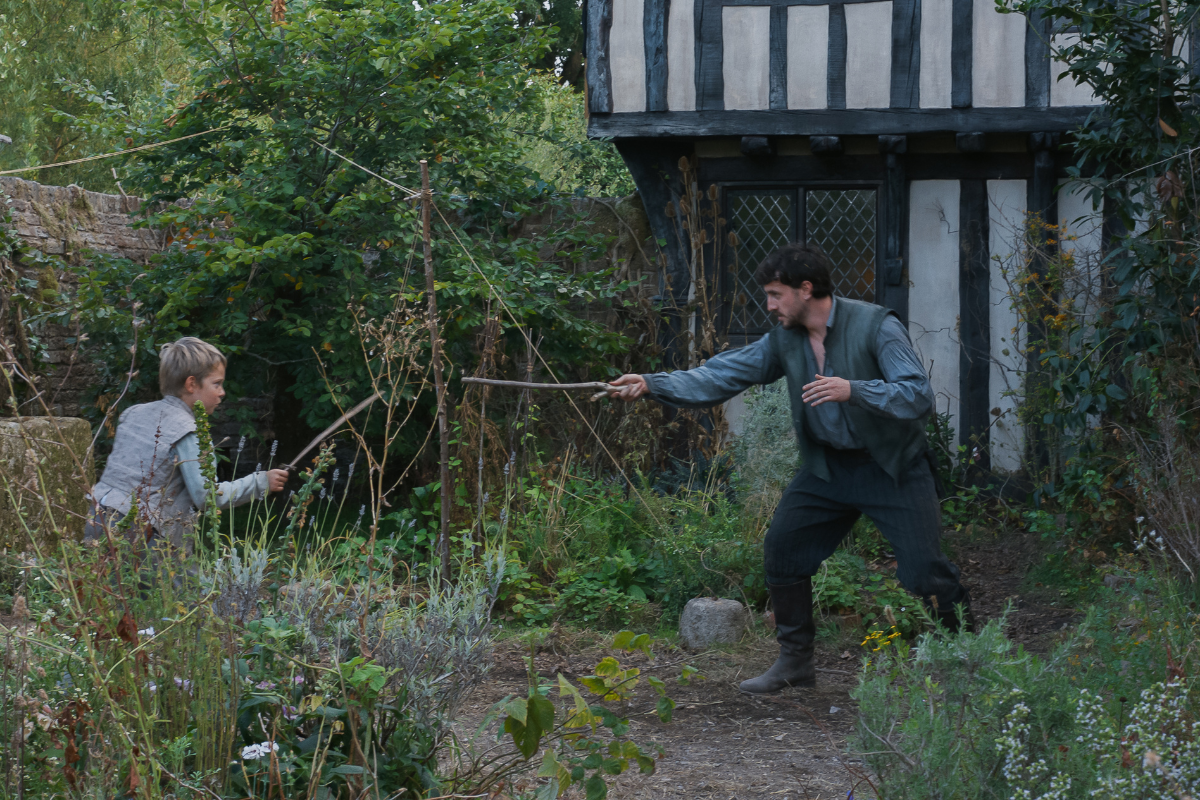A Family Dinner and a Global Disaster: A Conversation with ‘Humane’ Director Caitlin Cronenberg and Screenwriter Michael Sparaga
Caitlin Cronenberg and Michael Sparaga talk about how the initial idea was formed around a simple note “family dinner” to their creative collaboration, tapping into their personal sibling dynamics, and building out the visual language (and horror) of the film.
HUMANE takes place over a single day, mere months after a global ecological collapse has forced world leaders to take extreme measures to reduce the earth’s population. In a wealthy enclave, a recently retired newsman has invited his four grown children to dinner to announce his intentions to enlist in the nation’s new euthanasia program. But when the father’s plan goes horribly awry, tensions flare and chaos erupt among his children.
What would you do if the “trolley problem” was your only option for survival? And what kind of ethical and moral highroad would you need to take in order to solidify that decision – especially if it meant your family was involved. Now pair that with a dire global environmental catastrophe – and you’re off to the races. In Caitlin Cronenberg’s directorial debut, Humane, written by Michael Sparaga, there’s a unique visual language that captures the authentic character sibling dynamics, that makes their dilemma that more repugnant and honestly, breaks your heart.
Both Caitlin and Michael recently spoke with Script about how the initial idea was formed around a simple note “family dinner” to their creative collaboration, tapping into their personal sibling dynamics, and building out the visual language (and horror) of the film.
This interview has been edited for content and clarity.
Sadie Dean: What was the seed for the idea and then getting it down on paper?
Michael Sparaga: I actually have it on my phone, a little tiny note - I'll take notes and ideas as I'm walking through parks and stuff like that. It's from 2015, it's on my phone. It's just like a “family dinner.” And I come from almost the same size family as Caitlin - there's a lot of siblings. And it was just the idea that if the world had collapsed, before there was the pandemic, all you would read about is blackened skies over New Zealand, from forest fires in Australia, it just seemed so dire.
And I thought, the idea of running out of resources and how that would look and the idea that when we cull a herd of caribou, it's considered the right thing to do. And the idea is, could we do that to ourselves, could you humanely sort of cull our own population of that's what it was going to take for us to survive…I think, you often see this happening in movies, it's like, so everyone piled onto a big spaceship, and humanity's only option is to be on a spaceship and find a second home. And it's like, nowhere near that – we’re nowhere near like hundreds of thousands, and building massive arcs and sending ourselves into space. So I thought it's probably gonna have to take care of business down here and how that would look.
I’m a big fan of a movie called Last Night, which was a Don McKellar movie from years ago in which we have the same DP for actually. And that movie was in the summer of Armageddon, and Deep Impact was that other movie that was about the end of the world, and it just took place on the ground, nobody was picking up the red phone and saying, ‘Get me the President!’ It was just people dealing with it.
And so, I wanted to see if there was a way to sort of capture a global disaster or crisis. And then when I wrote it in 2019, that was pre-pandemic. And when I said to Cait, initially, it was pre-pandemic, and we hadn’t really seen it in our lifetime, how the world would react to a global environmental crisis, but the things built into the scripts, like people calling it like an Asian collapse, because they would cast blame. And we got to see some of that I would Kung-flu type stuff, the racism that would sort of boil over in some of this. So I think it became, sadly prescient. You don't want to think it is you know, and some of the TikToks we've been seeing where people, like, ‘Would you volunteer yourself?’ And it's like, ‘Oh, I did not expect to start that conversation,’ and people are like ‘I would in a heartbeat’ - I don't want to be in a world like this.
Caitlin Cronenberg: That was the biggest surprise for me. The TikTok generation is like, ‘Oh, you would have way more than 20%, all of us would volunteer.’ It was really, really interesting insight into what's going on in that generation.
Michael: They're like, ‘I don't even know why I'm alive. My parents should’ve taken a good look around - what a silly idea to bring someone into it. But here I am.’ 2015-2019, I wrote it.
Sadie: Caitlin, when you when you came on board, what initially caught your eye, especially from a director's perspective?
Caitlin: I really just enjoyed reading the script so much. And I thought that the concept was so original, and yet, so close to being something that is the reality that we're facing, but not in such a way that it was going to be a huge bummer to make and watch. Because, I mean, I've read dozens 1,000s, hundreds of scripts, and you just want to read something, especially when you're picking, for me, my very first project, I wanted to read something that was entertaining, smart, and enjoyable. And something that I knew I could spend the next five years of my life working on watching over and over again, reading over and over again and talking about, and it's very hard to find something like that - that really connects with you and gives you this excitement to say, ‘I will still be excited about this in five years.’ And here we are. And I'm still excited about it five years later. And I think that that was the first thing that really just grabbed me was this is very entertaining. And conceptually very interesting.
There's so many remakes in the world, so many Marvel movies, so many superhero things. And I just loved that there was an original concept. And it was very well thought out. The prospect of working on it with Michael, who's been a friend of mine for many, many years, was another thing because I said, you know, we're going to have a great experience working on this together. And that's a huge part of it too. Because of course, beginning your director journey, it's very daunting. And the idea of having someone with me who I knew would be an ally, like a partner - it was very appealing. And turns out, I was absolutely right. We had a great time.
Sadie: The sibling dynamic and characters are really great and resonate as authentic relationships. Michael, can you talk about getting those dynamics down on the page?
Michael: I'm from four siblings: two boys, and two girls. Older sister, older brother, and then the younger brother and sister. I’m the second youngest, and it was pairs kind of like that - my older siblings were the pair and then me and my little sister, we were the pair. And so, I knew that that dynamic would sort of hold true as I was writing, it just would feel familiar. And we're also all very different. I'm in the arts, my brothers in mergers and acquisitions. My sisters in social work. My other sister was a mom early And we often get, ‘I can't believe you're brothers and sisters,’ and we're just so full of differences. They really can't see it, but we're also supportive of one another and sometimes not was, it's in our tables are very lively, the conversations, there's a lot of joking around with each other a lot of ribbing each other.
And really the idea started with a family dinner party, I didn't know how far it would go from that. So that's the initial line in my on my phone. I knew I could write. It just raised the stakes and talk about what's happening in the world, which is often what's happening at those dinner tables.
Once you find the crisis that’s surrounding the table and the world at large, it was sort of easy to build. And these characters, their jobs and everything, those changed along with Caitlin. There were some conversations about who they are, what their jobs are. There was a bunch of little things that sort of changed as we wanted to really make sure they felt differentiated.
My first email to Caitlin was, ‘Have you ever thought of directing a feature?’ That was my subject heading. And I sent it to her. I loved the short she had done and I explained why I loved it and why think she'd be great for this - coming from a large family herself…So I thought, there's pressures there that maybe she might understand and she’d be able to bring more to the table. And she did.
Caitlin: Yeah, I think one of the biggest things for me, and Michael wrote it this way, as well, but I really wanted the family dynamic and the sibling dynamic, especially to be very natural. I wanted them to sound like they were really siblings the way that they speak to each other. I have an older brother and older sister, and we are all very different as well. And we speak to each other in different ways than we speak to each other. But my brother and I are four years apart. And it's such a natural flow, we have the same sense of humor, we're very close in a lot of ways. And so, I didn't have the two in two with the split in the same way, but it was more just their comfort level with each other, the way that they speak to each other how they address each other. I never call my brother Brandon. And they're just these little bits and hints of moments that we want it to make sure felt really, really natural and that flowed.
And I think shooting that dinner table scene was one of the best days - it was so incredible, because everyone was just at the top of their game with incredibly long monologues reacting to each other, constantly on, even if they weren't the ones that were on camera at the moment. And it was like a play unfolding. And the actors just dug in too, they were so there. I kept being like, ‘OK guys, good for another take?’ And they’re like, ‘Yes, let's keep going.’
And I think that a lot of the discussion happened also offline, like Michael and I would talk about the backstories of the characters and what we thought about their pasts and how we could sort of bring that to the actors and have conversations with them. Of course, this is every actor has a different process. Some actors show up, they've got their lines and they're like, ‘I'm good. I'm just gonna say my lines and be amazing. And I'm done.’ And some actors really want to talk about the intentions of the character, what their past looked like, you know, all of the details of their lives up to the moment that they arrive at the house. I think for me as a first-time director, especially, it was really fascinating to learn the different ways that actors like to work and get to have all of the different experiences with them.
Sadie: It feels authentic. And like you say, that dinner scene feels like a play, that the energy is there. I’d love to talk about your background as a photographer, Caitlin, and how that skill set influenced filming in one location – basically living inside this box – but also choosing your color palette, the production design, the costumes, and of course your collaboration with your DP Douglas Koch.
Caitlin: All of that is part of the same story. Doug, our DP, is an incredible collaborator. He has all the knowledge of cameras, of colors, of photography of everything. And he was down to talk about it for as long as we wanted. As soon as we got him on board, the conversations began there. He was involved in all of our scouting, he was involved in all of the discussions about production design, as well. And down to picking color chips for what color we were going to paint the walls and doing camera tests on the color chips in different lighting scenarios.
And I think that coming from a photographer's background, and then working with a DP in this kind of weird world, we wanted the lighting to be telling part of the story whether people will notice it or not. And it doesn't matter if the audience notices or not because they're going to feel it. And that was a big thing for me was there are two very distinct parts of this movie. The beginning is daylight. We're understanding the world-building. This is the family drama, everybody's coming together, we see people outside, people have umbrellas, the sky has a strange tone. Inside the house, there's film on all the windows, because this is part of protecting yourself from the sun's harmful UV rays.
And so, Doug and I really worked on coming up with the look and feel of the inside of the house during the day, with that film that stops down the light, but still lighting it to sort of feel like there's daylight outside. But then inside the house, the family is just used to it being a bit darker.
The transitional moment, of course, is the sunset scene with Peter. And that was meant to change the entire vibe. And from that moment on, we're in darkness. We’re lit by practical lights. A lot of the time it was really just practical lights and phones. And when we're using phones as light, we were really only using phones as light.
And I think that Doug was such a perfect partner for me on this because he wanted to go deep on the lighting. He wanted to talk to me about every single minute detail. We looked at so many examples of imagery that we both loved. And I think that for me, the idea that you could take any still frame from the movie and it's still going to be beautiful and tell the story on its own. And that was something that I really wanted to focus on coming from a photography background. Because if it's not beautiful then what did I just do for 20 years? [laughs]
But again, it's about surrounding yourself with that incredible team and Doug, he was the one, because you got to have someone who loves light and loves technology as much as he does. He was just totally dedicated to the project – it was incredible.
HUMANE will be available in select theaters on Friday, April 26th courtesy of IFC Films.
This 12-week course guides students through the process of building a feature film script, starting with an outline and continuing through all the acts of your screenplay.
Sadie Dean is the Editor of Script Magazine and writes the screenwriting column, Take Two, for Writer’s Digest print magazine. She is also the co-host of the Reckless Creatives podcast. Sadie is a writer and filmmaker based in Los Angeles, and received her Master of Fine Arts in Screenwriting from The American Film Institute. She has been serving the screenwriting community for nearly a decade by providing resources, contests, consulting, events, and education for writers across the globe. Sadie is an accomplished writer herself, in which she has been optioned, written on spec, and has had her work produced. Additionally, she was a 2nd rounder in the Sundance Screenwriting Lab and has been nominated for The Humanitas Prize for a TV spec with her writing partner. Sadie has also served as a Script Supervisor on projects for WB, TBS and AwesomenessTV, as well as many independent productions. She has also produced music videos, short films and a feature documentary. Sadie is also a proud member of Women in Film.
Follow Sadie and her musings on Twitter @SadieKDean


